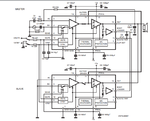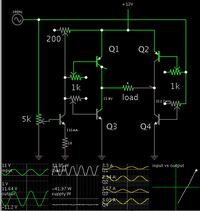julian403
Full Member level 5
I'm making an class AB amplifier and I must to do it with a simple source of 12 [V].

I did all the calculations for the polarizations. Where the fall in each transistor is Vcc / 2 and in this case is 6 V. For more power I put a transformer to the load. My first question is this. With a ratio of 1: 3 I have a power of 21 W but with a ratio of 1: 2 or 1: 4, that is, more or less I have a minimum power why?
A friend said to me that I can put another power amplifier in parallel for more power. But if I put two parallel stages I do not get twice, but a bit more than one . I mean I don't get 42 Watts but 33 Watts.

But if I change the value of the transformer ratio 1:3 to 1:4 I get twice the power. Why?

For every step that I put I up the number of turns of the secondary one for twice the power
From already thank you for the help

I did all the calculations for the polarizations. Where the fall in each transistor is Vcc / 2 and in this case is 6 V. For more power I put a transformer to the load. My first question is this. With a ratio of 1: 3 I have a power of 21 W but with a ratio of 1: 2 or 1: 4, that is, more or less I have a minimum power why?
A friend said to me that I can put another power amplifier in parallel for more power. But if I put two parallel stages I do not get twice, but a bit more than one . I mean I don't get 42 Watts but 33 Watts.

But if I change the value of the transformer ratio 1:3 to 1:4 I get twice the power. Why?

For every step that I put I up the number of turns of the secondary one for twice the power
From already thank you for the help




